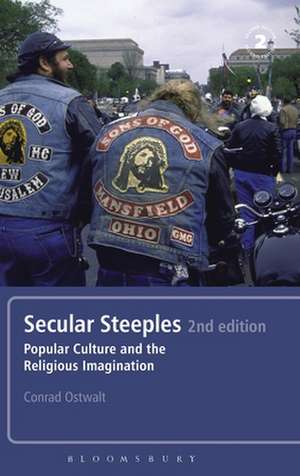Secular Steeples 2nd edition: Popular Culture and the Religious Imagination
Autor Dr. Conrad Ostwalten Limba Engleză Hardback – 26 sep 2012
Preț: 952.35 lei
Preț vechi: 1293.77 lei
-26% Nou
Puncte Express: 1429
Preț estimativ în valută:
182.23€ • 190.26$ • 150.82£
182.23€ • 190.26$ • 150.82£
Carte tipărită la comandă
Livrare economică 04-18 aprilie
Preluare comenzi: 021 569.72.76
Specificații
ISBN-13: 9781441156174
ISBN-10: 1441156178
Pagini: 288
Dimensiuni: 156 x 234 x 25 mm
Greutate: 0.7 kg
Ediția:Tion.
Editura: Bloomsbury Publishing
Colecția Bloomsbury Academic
Locul publicării:London, United Kingdom
ISBN-10: 1441156178
Pagini: 288
Dimensiuni: 156 x 234 x 25 mm
Greutate: 0.7 kg
Ediția:Tion.
Editura: Bloomsbury Publishing
Colecția Bloomsbury Academic
Locul publicării:London, United Kingdom
Caracteristici
Features contemporary secular examples of television, movies, literature and music which express religious messages.
Notă biografică
Conrad Ostwalt is Professor of Religious Studies and Chair of the Department of Philosophy and Religion at Appalachian State University, USA.
Cuprins
Acknowledgments \ 1. Popular Culture, theReligious Imagination, and the Evolution of God \ 2. Secularization-TheEvolution of Western Religion \ Part I:Pre-text \ 3. Space/Place/Pre-text \ 4. Megachurches \ 5. Love Valley: The Sacralization of Secular Space \ Part II: Text \ 6. Narrative/Text \ 7.Religion and Secular Text \ PartIII: Post-text \ 8. Image/Post-text\ 9. A Cinematic Secular Apocalyptic Imagination \ Part IV:Con-text \ 10.Communitas/Con-text \ 11. The Motorcycle as American Icon and Symbol of SacredJourney \ 12. Emerging Religion: MachineGuns, Post-Christian Churches, The Internet, Snakes, and Science \ Conclusion: Theological Appropriation of Secularization: A Cooperative Model \ Works Cited \ Index
Recenzii
'In this bold, thoughtful, and complex work, Conrad Ostwalt counters major currents in religious and theological studies that identify the nature and role of the religious and sacred by positing their contrary relation to the secular and profane. He argues and richly illustrates how and why these putative contraries are actually in constant and various involvements with and even dependencies on one another and how awareness of these relational dynamics can and should affect our understandings of both American culture and religion and theology.'
'More a reengagement than a revision, this second edition of Conrad Ostwalt's influential work on secularization, religion, and popular culture retains the best aspects of the original-a clear theoretical framework and relevant, entertaining examples-while incorporating not only new material, but also student-friendly features such as lists of key words and concepts, study questions, and even suggestions for guided readings.The first edition of Secular Steeples allowed readers to navigate the reciprocal relationship between religion and popular culture.This new edition will engage, educate, and entertain both previous and new readers alike.I look forward to using it in my classes.'
'In contrast to modern sociology's secularization theories, Ostwalt sees the sacred and the secular commingling as religious groups secularize by adopting secular forms and as secular forms and institutions betray religious sensibilities. New material in this edition includes forays into football stadiums, Harry Potter, 2012, motorcycles, and the emergent church. To place, text, and image, he now adds communitas. He also adds a chapter seeking to ground his theological view of postmodernism in process theology. Finally, his addition of questions, assignments, and reading suggestions will facilitate the use of the book in classrooms.'
'More a reengagement than a revision, this second edition of Conrad Ostwalt's influential work on secularization, religion, and popular culture retains the best aspects of the original-a clear theoretical framework and relevant, entertaining examples-while incorporating not only new material, but also student-friendly features such as lists of key words and concepts, study questions, and even suggestions for guided readings.The first edition of Secular Steeples allowed readers to navigate the reciprocal relationship between religion and popular culture.This new edition will engage, educate, and entertain both previous and new readers alike.I look forward to using it in my classes.'
'In contrast to modern sociology's secularization theories, Ostwalt sees the sacred and the secular commingling as religious groups secularize by adopting secular forms and as secular forms and institutions betray religious sensibilities. New material in this edition includes forays into football stadiums, Harry Potter, 2012, motorcycles, and the emergent church. To place, text, and image, he now adds communitas. He also adds a chapter seeking to ground his theological view of postmodernism in process theology. Finally, his addition of questions, assignments, and reading suggestions will facilitate the use of the book in classrooms.'
